小学六年级英语上册全册备课
- 格式:doc
- 大小:33.50 KB
- 文档页数:3
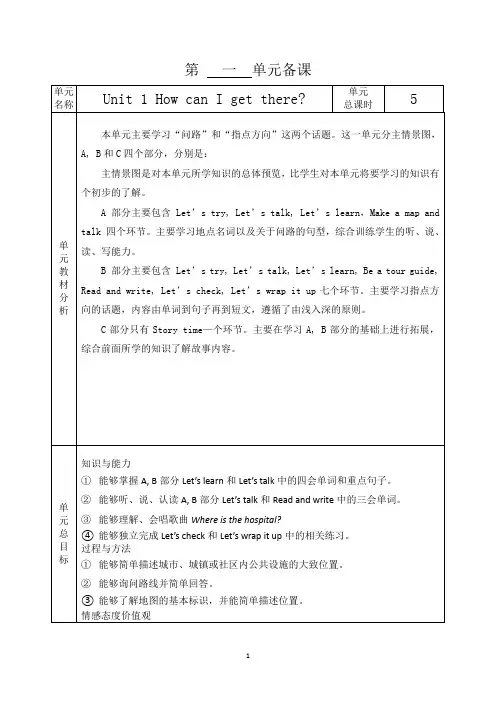
2. 课本个性化书写活动(1) Discuss with your partner. What are you going to do for Mid-autumn Festival?➢先让学生同桌口头交流。
➢教师将最后一位学生的回答在投影仪下示范书写,然后提出一星和两星要求,请学生个性化书写。
Step five: homework课后作业Write down your plan.For Mid-Autumn Festival, I’m going to ___________ ___________________. My partner is going to _________________________ ___________________.板书设计反思重建第 3 单元第 6 课时备课课题Unit 3--6课时安排1教学目标1.复习一般将来时态的三个核心问句以及回答:What are you going to do? When are you going? Where are you going?2.巩固一般将来时的句法要点,能够用不同的主语进行be going to的造句以及自由表达。
3.能理解、听懂并讲Story time中的故事。
学生能够用正确语音语调朗读语篇,并能够知道日记的格式。
培养自主学习能力重点难点重点:一般将来时的语法要点复习。
难点:能在实际情景中灵活运用以及正确的回答课前准备教师自制课件。
词卡,录音机,磁带基本环节集体资源个人增减教学过程Step One: warming up1. Free talks: What are you going to do? When are you going?Where are you going?Step Two: Wrap it up1.教师将提到的三个问题写到黑板上,并询问一般将来时的特点。
(1)be going toPractice: I _____ going to…He ____ going to see a film.They ____going to watch TV.(2)时间状语:this morning this afternoon this evening tonight tomorrow next week2. How many sentences can you make?(1) Talk about it in pairs.(2) Feedback.Step Three: Story Time1. Watch the video and answer the questions:2. Watch it again and learn some new words授课时间:。
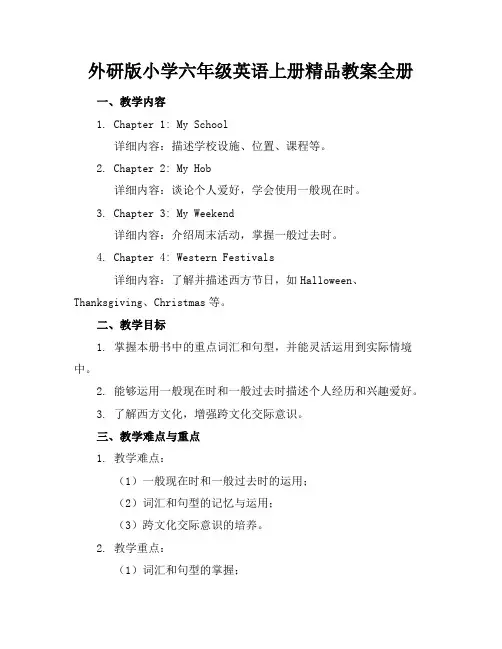
外研版小学六年级英语上册精品教案全册一、教学内容1. Chapter 1: My School详细内容:描述学校设施、位置、课程等。
2. Chapter 2: My Hob详细内容:谈论个人爱好,学会使用一般现在时。
3. Chapter 3: My Weekend详细内容:介绍周末活动,掌握一般过去时。
4. Chapter 4: Western Festivals详细内容:了解并描述西方节日,如Halloween、Thanksgiving、Christmas等。
二、教学目标1. 掌握本册书中的重点词汇和句型,并能灵活运用到实际情境中。
2. 能够运用一般现在时和一般过去时描述个人经历和兴趣爱好。
3. 了解西方文化,增强跨文化交际意识。
三、教学难点与重点1. 教学难点:(1)一般现在时和一般过去时的运用;(2)词汇和句型的记忆与运用;(3)跨文化交际意识的培养。
2. 教学重点:(1)词汇和句型的掌握;(2)时态的正确运用;(3)实际情境中的语言运用。
四、教具与学具准备1. 教具:PPT、实物、卡片、黑板等。
2. 学具:课本、练习本、彩笔等。
五、教学过程1. 导入:通过PPT展示学校图片,引导学生谈论学校的相关内容。
2. 新课内容呈现:讲解新词汇和句型,通过例句和实际情景进行展示。
3. 例题讲解:针对难点和重点进行讲解,让学生学会运用。
4. 随堂练习:分组进行口语练习,巩固所学知识。
6. 课后作业布置:布置作业,明确作业要求和完成时间。
六、板书设计1. 外研版小学六年级英语上册2. 内容:各章节重点词汇、句型,时态归纳,板书设计要求简洁明了。
七、作业设计1. 作业题目:(1)用一般现在时描述你的学校和兴趣爱好;(2)用一般过去时描述你的周末活动;(3)介绍你所了解的西方节日。
2. 答案:见附件。
八、课后反思及拓展延伸1. 课后反思:根据学生的作业完成情况,反思教学效果,调整教学方法。
2. 拓展延伸:(1)鼓励学生通过查阅资料,了解更多关于西方节日的知识;(2)开展小组活动,让学生互相介绍学校和兴趣爱好,提高口语表达能力;(3)组织英语角活动,让学生在实际情境中练习英语,提高跨文化交际能力。
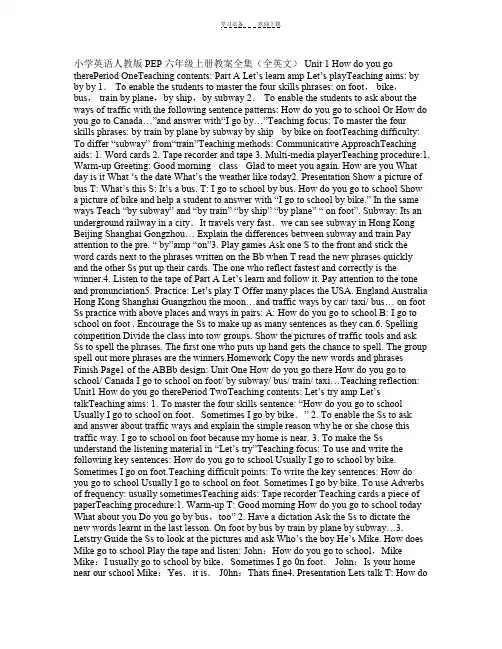
小学英语人教版 PEP 六年级上册教案全集(全英文) Unit 1 How do you go therePeriod OneTeaching contents: Part A Let’s learn amp Let’s playTeaching aims: by by by 1. To enable the students to master the four skills phrases: on foot, bike,bus, train by plane,by ship,by subway 2. To enable the students to ask about the ways of traffic with the following sentence patterns: How do you go to school Or How do you go to Canada…”and answer with“I go by…”Teaching focus: To master the four skills phrases: by train by plane by subway by ship by bike on footTeaching difficulty: To differ “subway” from“train”Teaching methods: Communicative ApproachTeaching aids: 1. Word cards 2. Tape recorder and tape 3. Multi-media playerTeaching procedure:1. Warm-up Greeting: Good morning class Glad to meet you again. How are you What day is it What ‘s the date What’s the weather like today2. Presentation Show a picture of bus T: What’s this S: It’s a bus. T: I go to school by bus. How do you go to school Show a picture of bike and help a student to answer with “I go to school by bike.” In the same ways Teach “by subway” and “by train” “by ship” “by plane” “ on foot”. Subway: Its an underground railway in a city.It travels very fast.we can see subway in Hong Kong Beijing Shanghai Gongzhou… Explain the diffe rences between subway and train Pay attention to the pre. “ by”amp “on”3. Play games Ask one S to the front and stick the word cards next to the phrases written on the Bb when T read the new phrases quickly and the other Ss put up their cards. The one who reflect fastest and correctly is the winner.4. Listen to the tape of Part A Let’s learn and follow it. Pay attention to the tone and pronunciation5. Practice: Let’s play T Offer many places the USA. England Australia Hong Kong Shanghai Guangzhou the moon…and traffic ways by car/ taxi/ bus… on foot Ss practice with above places and ways in pairs: A: How do you go to school B: I go to school on foot . Encourage the Ss to make up as many sentences as they can.6. Spelling competition Divide the class into tow groups. Show the pictures of traffic tools and ask Ss to spell the phrases. The first one who puts up hand gets the chance to spell. The group spell out more phrases are the winners.Homework Copy the new words and phrases Finish Page1 of the ABBb design: Unit One How do you go there How do you go to school/ Canada I go to school on foot/ by subway/ bus/ train/ taxi…Teaching reflection: Unit1 How do you go therePeriod TwoTeaching contents: Let’s try amp Let’s talkTeaching aims: 1. To master the four skills se ntence: “How do you go to school Usually I go to school on foot.Sometimes I go by bike.” 2. To enable the Ss to ask and answer about traffic ways and explain the simple reason why he or she chose this traffic way. I go to school on foot because my home is near. 3. To make the Ss understand the listening material in “Let’s try”Teaching focus: To use and write the following key sentences: How do you go to school Usually I go to school by bike. Sometimes I go on foot.Teaching difficult points: To write the key sentences: How do you go to school Usually I go to school on foot. Sometimes I go by bike. To use Adverbs of frequency: usually sometimesTeaching aids: Tape recorder Teaching cards a piece of paperTeaching procedure:1. Warm-up T: Good morning How do you go to school today What about you Do you go by bus,too” 2. Have a dictation Ask the Ss to dictate the new words learnt in the last lesson. On foot by bus by train by plane by subway…3. Letstry Guide the Ss to look at the pictures and ask Who’s the boy He’s Mike. How does Mike go to school Play the tape and listen: John:How do you go to school,Mike Mike:I usually go to school by bike.Sometimes I go 0n foot. John:Is your home near our school Mike:Yes.it is. J0hn:Thats fine4. Presentation Lets talk T: How doI go to school,do you know Ask me,please Draw a bike a bus a taxi on the Bb and write the price by each picture. bus 1 yuan taxi 10 yuan Encourage the Ss to ask“How do you go to school T: Usually I go to school by bike because its good exercise.Sometimes I go by bus, but because its cheap.It costs l yuan. Sometimes I go by taxi,because its fast, its too expensive.It costs 1o yuan. Explain that we use usually and sometimes to express frequency. T: “How does Sarah go to school Listen.” Ask the S to imitate Sara h’s tone to answer Sarah: Usually I to go school on foot. Sometimes I go bike. Ss read after the tape. Then practice in pairs to make up the new dialogue according to each picture. Ask several pairs to act out the dialogue. 5.Group work Read the dialogue .Then practice in groups of four. They can expand their dialogue like the following: A:Howdo you go to school/ hometown B:Usually I go by bus. A:Can you go by bike I but B: Yes, can, its too far. Sometimes I go by taxi,because it’s fast but its expensive. What about you A:I go to school on foot,because my home is near. 6.Play finding order games Show the following word cards and ask Ss to form correct sentences. How do go to school you I usually on go school to foot Sometimes by bike go I Homework: Finish AB Page2 Bb design Unit1 How do you go there How do you go to school Usually I go to school on foot because it’s near. Sometimes I go by bike because it’s fast. Period ThreeTeaching contents: Let’s readTeaching aims: 1. To improve reading skill 2. To consolidate the traffic ways 3. To improve understanding ability. 4.Teaching focus: How do we go to the park It’s easy. How to finish answering the questions in the bookTeaching difficult points: How to express the different ways to a placeTeaching aids: Tape recorder a piece of paper masks of Zhang Peng and SarahTeaching procedure:1. Review Free talk2. Dictation How do you go to school Usually I go to school on foot. Sometimes I go by bike. What about you3. Review different places T: This is a very nice place. There are many students and teachers. There are many rooms such as classroom art room music room… What’s it It’s a beautiful place. Many people like to play in it. There are nice flowers trees and grass. There are toys. What is it It’s a park.4. Pr esentation T: Where is my home Do you want to know Describe with different traffic ways and use “first” “next” “then” . It’s a little far from here. First I go to Zenbu bus stop on foot. Then I can go by the No.74 bus to the East Bus Station... We live on the ninth floorRoom902. Explain “then”5. T ask individual : Where is your home Is it near the park Which floor In pairs practice above questions6. Play the tape and students follow it. Ask: How can we go to Sarah’s home How can they go to the park Finish a nswering the questions then check the answers.7. Practice Read the text. Boys to be Zhang Pengand girls to be Sarah. Work in pairs to read the dialogue. Ask several pairs to act out.8. Make up new dialogues Homework: Do Page 5 in AB Make a survey and fill in the following form Name Destination What can you see there How do you go thereBb design: How do we go to the park It’s easy. Which floor The fifth floor Room 5A Period FourTeaching contents: Let’s learn and Let’s playTeaching aims: 1.To master the phras es: Stop at a red light. Wait at a yellow light. Go at a green light.5. To know some traffic rules about traffic lightsTeaching focus: To understand the traffic lights commands and do the action: Stop at a red light. Wait at a yellow light. Go at a green light.Teaching difficult points: The meaning of the three traffic lights and do the correct action of the commandsTeaching aids: Tape recorder a flash card of traffic lights word cardsTeaching procedure:1. Free talk2. Warm-up Ask Ss to do actions when they hear the order Stand up touch your ears turn Left right go turn around…3. Review How do you go … Ss should make a trueanswer and give the reason.4. Revise the words of colours5. T: show traffic lights What are they They are traffic lights. T: How many colour What colours are they What do they mean T show a red light and say: It’s a red light. I must stop at a red light. It’s a yellow light. I must wait at a yellow light. It’s a green light. I can go at a green light. Do you know the traffic rules Draw three traffic lights on the Bb and write the traffic rules next to them Stop at a red light. Wait at a yellow light. Go at a green light.6. Play the tape and Ss follow it. Explain “remember” by doing gesture.7. Let’s play Ask ten students to the front to do actions of traffic lights commands Five girls are Group A. The other boys are Group B. When T show the yellow light they must wait. If not the one who disobeys Should get back to the seat. In the end the group with more people win the game.8. Consolidation and extension Discuss the different traffic ways and rules How do you go to school I go to school On foot.Can you tell me any traffic rules You must watch the traffic 1ights. I go to school by bus.Can you tell me any traffic rules Dont run in the bus. Dont stick your head Or arms out Of the window. I go to school by bike.Can you tell me any traffic rules Dont go too fast. Never go into the sideways.Homework: Copy the traffic rules written on the Bb Finish AB Page4Bb design: Traffic lights traffic rules Red light Stop at a red light. Yellow light Wait at a yellow light Green light Go at a green light.Teaching reflection: Period 5Teaching contents: Let’s readTeaching aims: 1. To improve reading skill 2. To consolidate the traffic rules and know different countries have different traffic rules. 3. To improve understanding ability and make Ss get right information from the reading material.Teaching focus: Understanding the the meaning of the text and finishing the “tick or cross”Teaching difficult points: To im prove the reading skills To understanding the following sentences: In China/the US,drivers drive on the right side Of the road. In England and Australia,however,drivers drive On the 1eft side Of the road.Teaching aids: Tape recorder flash card of traffic lights A photo of Singapore streetTeaching procedure:1. Free talk2. Review Stop at a red light. Wait at a yellow light. Go at a green light. Let the Ss do the actions Dictate the above sentences.3. T: put up the right hand This is my right hand. Show me your right hand Then show me your left hand. Do actions as I tell you: Turn left. Turn right. Turn back. Touch your left ear…4. Discuss traffic rules T: Red means “stop” .if the light is red you must stop. Yellow means________ if the light is yellow you must ______. Green means _________ if the light is green you can ________.5. Show a photo of Singapore street and ask the Ss to find out the differences. T: The traffic lights are the same in every country. But what about other traffic rules Look at the picture. It’s in Singapore. what ‘s the differences. Help the Ss to answer: In Singapore the driver is on the left side. In China the driver is on the right side.6. Read Ask the Ss to read the passage and do the exercises. Check the answer together. Teach new words: Find difference every country Always drive if must Know England Australia however Explain the following sentences: In China drivers drive on the right side of the road. In England and Australia however drivers drive on the left side of the road. Read the text again and put up any questions. Homework Ask Ss to find more traffic rules Bb design The same every country always Mean drive right side England Australia However if must knowTeaching reflection Period 6Teaching contents: Part A Let’s try amp Let’s talkTeaching aims:1. To enable the students to master the four skills sentences: “How Can I get to Zhongshan Park You can go by the No.15 bus. 2. To enable the students to use polite words in dialogue: Excuse me. Thank you. You’re welcome. 3.To Review the names of places: post office supermarket cinemabank hospital fast food shop…Teaching focus: How can I get to Zhongshan Park You can go by the No.15 bus.Teaching difficulty: How to use “how can I get to …””you can go by…”correctly The meaning of “If you like”Teaching methods: Communicative ApproachTeaching aids: 1.Tape recorder and tape 2.Multi-media player 3.A map of Dongguan city.Teaching procedure:1. Free talk2. What day is it today How many students are there in your class Who is No.1/2…3.Go over the traffic rules: I Its a yellow light, must wait. I Now the light is green, can go.Dont go at a red light. A car may hit you.4.Go over the numbers from 1-100.Pay attention to 30 13 40 14 50 15 16 60 70 17 18 80 90 195.Lets try Play the tape of this part and students listen and tick.Man:Excuse me how can I get to Dongfang Primary School Zhang:You can go by the No.14 bus.Its next to the nature park. Man:Thank you. Zhang:Youre welcome. Play again and Ss repeat.6. Presentation Lets talk Show a traffic map ofDon gguan and ask Where is place/ bus number Show the map in the book What’s near the bus stop Teach: supermarket cinema bank hospital fast food shop bookstore school Let’s the students find the places on the map. Play the tape of this part and get the Ss re ad after it. Explain: If you like. Ask: T: I want to buy some fruit and clothes . Where should I go Where is the supermarket How can I get to the supermarket Show the traffic map of Dongguan. Get the Ss ask and answer: A: Excuse me How can I get to Walmarket B: You can go by the No….bus. Ask several pairs to act out.Homework: Do Exercise 3amp 4 of Ab Page5Bb design: How can I get to Ahongshan Park You can go by the No.15 bus. If you like. .。

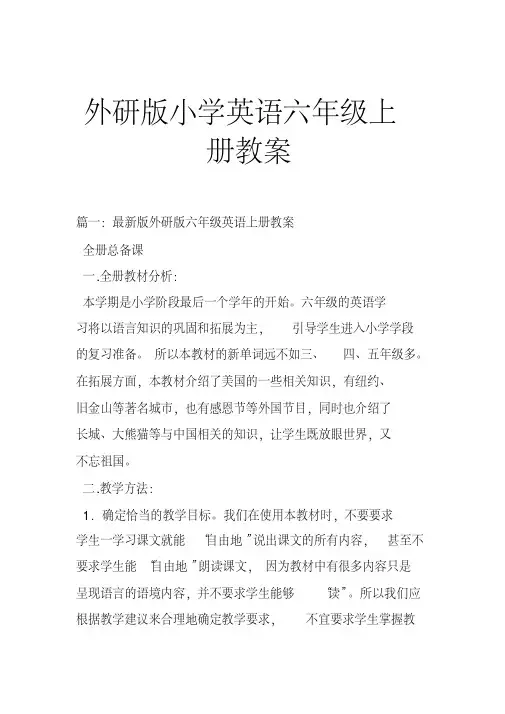
外研版小学英语六年级上册教案篇一:最新版外研版六年级英语上册教案全册总备课一.全册教材分析:本学期是小学阶段最后一个学年的开始。
六年级的英语学习将以语言知识的巩固和拓展为主,引导学生进入小学学段的复习准备。
所以本教材的新单词远不如三、四、五年级多。
在拓展方面,本教材介绍了美国的一些相关知识,有纽约、旧金山等著名城市,也有感恩节等外国节目,同时也介绍了长城、大熊猫等与中国相关的知识,让学生既放眼世界,又不忘祖国。
二.教学方法:1.确定恰当的教学目标。
我们在使用本教材时,不要要求学生一学习课文就能“自由地”说出课文的所有内容,甚至不要求学生能“自由地”朗读课文,因为教材中有很多内容只是呈现语言的语境内容,并不要求学生能够“读”。
所以我们应根据教学建议来合理地确定教学要求,不宜要求学生掌握教材上的全部文字内容。
2.创造良好的学习氛围。
3.在课堂上尽量使用英语,适当使用汉语。
4.纠正学生的语言错误5.利用录音带或CD-ROM,有效使用现代教育技术Module 1总备课知识与技能:全体学生能朗读课文,阅读相关短文,并能按要求完成语句书写。
过程与方法:对所学内容主动复习和归纳。
情感态度与价值观:乐于接触外国文化,增强祖国意识。
第一课时Unit 1It’s more than twenty thousand kilometers long.【教学目标】:知识与技能:1. These postcards are great .2. It’s a picture of the Great Wall .3. How long is the Great Wall ?It’s about six thousand seven hundred kilometers .过程与方法:讲述关于某个地方或某件事物的情况。
情感、态度和价值观:【重点】:words and phrase: postcard more thousand kilometer million Mexico Canada【难点】:Sentences: Tell me more about the Great Wall. It’s a picture of great wall.【课时安排】:1课时【教学过程】:(一)导入:老师热情地问候学生们,欢迎他们在暑假过后回到学校。

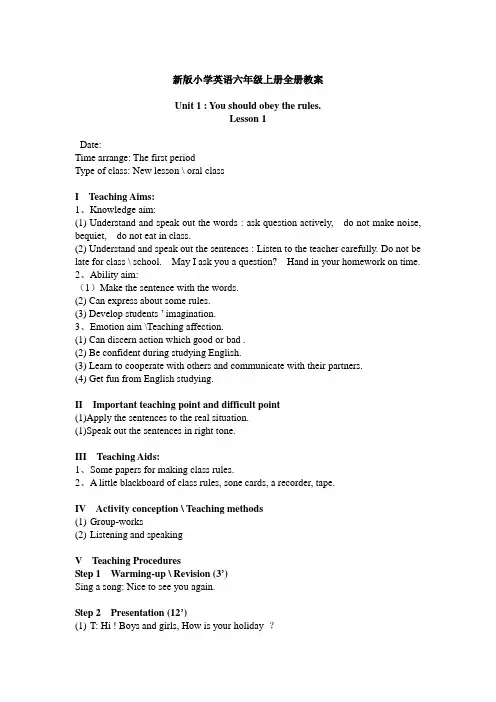
新版小学英语六年级上册全册教案Unit 1 : You should obey the rules.Lesson 1Date:Time arrange: The first periodType of class: New lesson \ oral classI Teaching Aims:1、Knowledge aim:(1) Understand and speak out the words : ask question actively, do not make noise, bequiet, do not eat in class.(2) Understand and speak out the sentences : Listen to the teacher carefully. Do not be late for class \ school. May I ask you a question? Hand in your homework on time.2、Ability aim:(1)Make the sentence with the words.(2) Can express about some rules.(3) Develop students ’ imagination.3、Emotion aim \Teaching affection.(1) Can discern action which good or bad .(2) Be confident during studying English.(3) Learn to cooperate with others and communicate with their partners.(4) Get fun from English studying.II Important teaching point and difficult point(1)Apply the sentences to the real situation.(1)Speak out the sentences in right tone.III Teaching Aids:1、Some papers for making class rules.2、A little blackboard of class rules, sone cards, a recorder, tape.IV Activity conception \ Teaching methods(1)Group-works(2)Listening and speakingV Teaching ProceduresStep 1 Warming-up \ Revision (3’)Sing a song: Nice to see you again.Step 2 Presentation (12’)(1)T: Hi ! Boys and girls, How is your holiday ?(2)Ss:------(3)T:New semester is begin, how are you going to study in the new semester?(4)Ss:------(5)Please, have a look, How is Gao Wei going to do in the new semester.(6)Ss : Open the book and observe the picture..(7)Listen to the tape and answer some questions.(8)T : may I ask you a question? How student is Gao Wei?(9)Ss : Gao Wei is good student.(10)T: Why to say that?(11)Ss: He comes to school early. He listen to his teacher carefully. He is a groupleader.(12)T :Yes, he knows everyone in school should obey the rules. T:Write the blackboard design: Unit1 You should obey the rules.(13)Ss :Read the topic.(14)T : How about you, boys and girls ?(15)Ss :------(16)T: Gao Wei’s group is making a list of rules for the class. What rules do youknow? Let’s read the class rules. (Show the class rules with little blackboard) (17)T: Teach the sentences and words with some actions.Step 3 Practice (20’)(1)T : May I ask you some questions ? Who’s your group leader ? Is he \she fit forthis task ? Why do you say that ?(2)Ss:------(3)Make our class rules in your group, please.Step 4 Assessment (5’)(1)Report the class rules.(2)Read the class rules.(3)T: Let’s obey the class rules. You should obey the rules.VI HomeworkRead the class rules to your group leader .VI The blackboard designUnit 1 You should obey the rules. Lesson 1Listen to teacher carefully.Hand in you homework on time.Don’t be late for class. Don’t make noise in class. VII Back courtingLesson2Date:Time arrange: The second periodType of class: Practice lessonI Teaching Aims1、Knowledge aim:(1) Can act with sentences.(2)Can advise others how to obey the class rules.(3) Can correctly write the words and sentences .(4) Can read and chant : Let’s read and chant2、Ability aim :(1) Develop the student’s imagination.(2)Can apply the sentences to the real situation.3、Teaching affection :(1) Foster the Ss have a good habit.(2)Improve the Ss’ discrimination.(3) To promote the Ss’ interest.II Important teaching point and diffeculte teaching point1、Can advise correct suggestion to others in the real situation.2、Pay attention to the Ss’ pronunciation and tones.III Teaching Aids :Some objects for action, recorder ,picture card.IV Teaching Methods(1)TPR happy teaching method(2)Listening and Speaking(3)Direct Method(4) Group workV Teaching ProceduresStep 1 Warm up \ Revision (5’)(1)Duty-reportAct out with the card.Step 2 Presentation (15’)Let’s talk(1)T: What’s he \ she doing ? She \He right or wrong ? (Show the card) Tellthem to obey the school rules,please.(2)Observe the picture of “Let’s tall”. Tell them how to obey theschool rules . Talk to your group.(3)Write the word and sentence.Step 3 Practice (10’)Let’s read and chant(1)Read to your partner.(2)Listen to the tape.(3)Chant together.Step 4 Assessment (10’)Write the words and sentences .VI HomeworkDictation the words and sentence.VII The blackboard designUnit 1 Lesson 2School rules :Don’t ------You should ------ VIII Back courtingLesson 3Date :Time arrange :The third periodType of class : New lessonI Teaching Aims1 Knowledge aim :(1) Understand and speak out the words: help to set the dinner table, go to bed early, keep your room clean, make a mess, should, shouldn’t.(2) Understand and speak out the sentences: You should help to set the dinner table. You should go to bed early. You should keep your room clean. You shouldn’t read in bed. You shouldn’t watch TV till late. You shouldn’t make a mess in your room.2 Ability aima :(1) Make sentences with the words .(2) Can advise correct suggestion to others .3 Teaching affection :(1) Be confident during studying English .(2) Learn to cooperate with others and communicate with their partners .(3) Get fun from English studying.II Teaching important and difficult points(1)Can speak out the sentences in right tone.(2)Apply the sentences to the real situation.III Teaching AidsPicture card, recorder-tape, stickers.IV Teaching Methods1 Situational teaching method2 Direct teaching method3 Listening and speaking4 TPR happy teaching methodV Teaching proceduresStep 1 Warming up \ Revision (5’)Have a race: Make sentences .Step 2 Presentation (15’)(1)Listen and discrimminate wich manner is good or bad.(2)Let’s have a look some picture of the lesson 3. Guess ,is Peter a goodstudent or good boy ?(3)Listen to the tape and answer the question.(4)Teach the words and sentences.(5)Do you want to talk with Peter ? Tell him how should to do.(6)Thing over it ,what does Peter’s mother write for him ?(7)Read the home rules.Step 3 Practice (15’)Talk about your home rules in your group.Step 4 Assessment (5’)Read the home rules to your group leader.VI HomeworkMake a home rule for yourself.VII The Blackboard designUnit 1 Lesson 3You should--------You shouldn’t------VIII Back courtingLesson 4Date:Time arrange: The fourth periodType of class: Consolidation lessonI Teaching Aims1 Knowledge aim:(1)Understand and speak out the words : keep your desk clean , make a mess , help to set the dinner table , go home too late .(2) Understand and speak out the sentences : You should go to bed early . You shouldn’t make a mess in your room .(3)Make alest of home rules put it in your living room .(4)Let’s read and chant .3、Ability aim:(1) Make sentences with words.(2)Make home rules fom yourself.(3) Develop the Ss ’imagination.3、Teaching affection(1)Be confident during English .(2) Learn to cooperate with others and communicate with their partners .(3) Get fun from English studying.II Important teaching point and difficult pointSpeak out the sentences in right tone and apply the sentences to the real situation .III Teaching Aidspicture card , recorder , stickers .IV Teaching Methods1 TPR teaching method2 Situational teaching method3 Direct teaching method4 Listening and speakingV Teaching ProceduresStep1 Warming-up \ Revision(1)Duty-reportTalk about you home rule .Step 2 Presentation(1)Apprase these manner right or bad each other .(2)Advise others how to make the home rule and obey the rules .(3)Write the sentences in your excisese bookStep 3 PracticeLet’s read and chantStep 4 AssessmentRead the words and sentences to your group leader.VI HomeworkWrite the sentences and dictation the words and the sentences . VII The blackboard designWe should ------We shouldn’t -------Lesson 5Date :Time arrange: The fifth periodType of class : Oral lessonI Teaching Aims1 Knowledge aim:(1) Understand and speak out the words: take good care of young children , keep off the grass , play on the street , spit on the ground , litter , wait , must .mustn’t.(2) Understand and speak out the sentences : Look out ! You must wait .You mustn’t pick the flowers . You mustn’t cross the road now . You must wait for the green light .2 Ability aim :(1) Can make sentences with the words .(2) Apply the sentences to the real situation .(3) Develop the Ss’ imagination .3 Teaching affection(1) To promote the Ss’ interest .(2) To foster the dialogue confidence .(3) Learn to cooperate with others and communicate with their partners .II Important teaching poit and difficult point(1)Can speak out the words and sentences in right tone .(2)Apply the sentences to the real situation .III Teaching Aidspicture cards , recorder , some objects .VI Teaching Methods1Situational teaching method2Direct teaching method3TPR teaching methodV Teaching proceduresStep 1 Warming-up \ Revision (3’) Let’s sing : Traffic lightStep 2 Presentation (17’)(1) T :Shows the picture cards : What’s he \ she doing ?That’s right or wrong ?Ss : You should ------You shouldn’t ------T : We must ------We mustn’t ------(3)Listen to the record and reapt(4)Read the dialogue in your group .Step 3 Practice (15’)Have a race : Act the dialogue .Step 4 Assessment (5’)Write the words and sentences .VI HomeworkRead the dialogue to your group leader .VII The Blackboard designUnit 1 Lesson5Look out !You must wait !You mustn’t ------ VIII Back courtingLesson 6Date :Time arrange : The sixth periodType of class : Practice lessonI Teaching Aims1 Knowledge aim(1) Act and speak out the words : respect old people and help them ,take good care of young children , keep off the grass , play on the street , spit on the ground , litter .(2)Can act the sentences : Look out ! You mustn’t cross the road now ! You must wait .(3) Can write and dictation the words and sentences .(4) Make a sign to tell people what they mustn’t \ must do .(5) Let’s read and chant2 Ability aimCan advise others how to obey the traffic rules and helps others .4Teaching affection(1)To foster the Ss’ cooperation .(2)To foster the dialogue confidence .(3)To foster the Ss’ interest .II Teaching important and difficult points(1)Apply the sentences to the real situation .(2)Pay attention to the Ss’ pronunciation .III Teaching AidSome objects , picture card , recorder .IV Teaching Methods1Direct Teaching Method2Situational Teaching Method3TPR happy Teaching MethodV Teaching proceduresStep 1 Warming-up \ revision (5’)(1)Listen and do(2)Sing the traffic song .Step 2 Presentation (15’)(1)Pick up some one and speak out traffic rules with their action .(2)Listen and act .(3)Read the pictures cards .(4)Make a traffic sign and talk in your group .(5)Write the words and sentences .Step 3 Practice (10’)Let’s read and chantStep 4 Assessment (10’)Write the words and sentences .VI HomeworkDictation the words and sentences to your group leader .VII The blackboard designUnit1 Lesson 6You must ------You mustn’t ------RevisionDate :Time arrange : The seventh perionType of lesson : Consolidation lessonI Teaching Aims1 Knowledge aim(1) Can read and understand the story .(2) Can speak out these rules to others .2 Ability aim(1) Can act the story to the real situation .(2) Can advise correctly suggestion to others .(3) Develop the Ss’ imagination .3 Teaching affection(1) To promote the Ss’ interest .(2) To foster the Ss’ cooperation .(3) To foster the dialogue confidence .II Teaching important and difficult points(1)Apply the sentences to the real situation .(2)Pay attention the Ss’ pronunciation .III Teaching AidsObject , recorder , picture card ,stickers ,headprops . IV Teaching Methods1Situational teaching method2Direct teaching method3TPR happy teaching method4 Listening and speakingV Teaching proceduresStep 1 Warming-up \ Revision (5’)Listen and doStep 2 Presentation (15’)(1)Look at the picture and listen to the tape . Then , try to answer thesequestions : who are they ? What are thy doing ? What sign is the dog holding up ? What sign is the panda holding up ? What sign is the rabbit holding up ? What sign is the Mimi holding up ? What sign is the Micky holding up ?(2)Read the story in your group .Step 3 Practice (15’)Act the story .Step 4 Assessment (5’)Make dialogu in your partners .VI HomeworkRead the story to your leader .VII The Blackboard designThe panda’sign : keep off the grass !The dog’ sign : no crossing !The rabbit’ sign : Be quiet !The cat’ sign : Look out !The Micky’ sign : No littering !VIII Back courtingUnit 2 I usually go to school by bus .Lesson 7Date :Time arrange : The first periodType of class : Oral lessonI Teaching Aims1 Knowledge aim(1) Understand and speak out the words : go to school , morning , at , AM .(2) Understand and speak out the sentences : I go to school at 7:00 in the morning .(3) Study e-mail’s format .(4) Can write the words and sentences .2 Ability aim(1) Can make sentences with the words .(2) Can apply the sentences to the real situation .3 Teaching affection(1) To promote the Ss’ cooperation .(2) To foster the Ss’ interest .(3) To foster the Ss’ confidence .(4) To foster the Ss’ good habit(5) To know the west ’ cultures .II Teaching important and difficult point .1Apply the sentences to the real situation .2Pay attention the Ss’ pronunciation and tones .III Teaching AidsCountry flags , recorder , picture card , stickers .IV Teaching Methods1Direct teaching method2Situational teaching method3Listening and speaking4TPR happy teaching methodV Teaching proceduresStep 1 Warming-up \ Revision (3’)(1)Sing a song : I want to be your friend .(2)GreetingStep 2 Presentation (17’)(1)T : Guess, where does they come from ?( Show the pictur.)(2)Listen and answer some questions : Where does Lucy come from ? What’sthe e-mail about ?(3)Talk about your daily life .(4)Read the e-mail .Step 3 Practice (10’)Talk about your daily life to partners .Step 4 Assessment (10’)Read the words and sentences to your group leader .VI HomeworkWrite the words and sentences .VII The Blackboard designLesson 7Lucy’ daily life :Get up : Go to school:Have classes : Go home :Watch TV : Go to bed : VIII Back courtingLesson 8Date:Time arrange :The second periodType of class : Practice lessonI Teaching Aims1 Knowledge aim(1) Understand and speak out the words : have breakfast ,have lunch , have dunner ,go to school , have classes , go home , watch TV , go to bed , 7:00 AM , 12:00 , 6 :00 PM .(2) Understand and speak out the sentences : I go to school at 7 :00 in the morning . I go to bed at 9 :oo in the evening .(3) Can dictation the words and the sentences .(4) Let’s make motes .(5) Let’s read and chant .2 Ability aim(1) Can introduce my daily life to others .(2) Can make notes .(3) Develop the Ss’ imagination .3 Teaching Affection(1) Have a nice habit .(2) To promote the Ss’ cooperation .(3) To foster the Ss’ confidence .II Teaching important and difficult point(1)Apply the sentences to the real situation .(2)Attention the Ss’ pronunciation and tones .(3)Can dictation the main words and sentence .III Teaching Aidspicture card , recorder , stickers , clock .IV Teaching Methods1 Direct Teaching Method2 Listening and SpeakingV Teaching ProceduresStep 1 Warming-up \ Revision (5’)Sing a song : I have --- in the ---Read the wordsStep 2 Practice (15’)(1)T: We usually go to school .What time do you usually go to school ?(Show the clock . )(2)Introduce your daily life .(3)Listen to the tape and repeat .Step 3 Practice (15’)Make the sentences with words .Make your daily life note in your group .Let’ read and chant .Step 4 Consolidation (5’)Write the main words and sentence .VI The homeworkDictation the master words and sentence to your group leader .VII The black board designUnit 2 Lesson 8I have breakfast at__________________I have lunch at _____________________I have dinner at __________________________I go to school at 7:00 in the morning VIII Back CourtingLesson 9Date :Time arrange :The third periodType of class : Oral lessonI Teaching Aims1 Knowledge aim(1) Understand and speak out the words : get up , get home , take a long walk ,water the flowers ,play with his pet dog ,best wishes .(2) Understand and speak out the text .2 Ability aim(1) Make the sentence with the words .(2) Can introduce about others’ daily life .(3) Affection aim(1) To promote the Ss’ conffidence and interest .(2) To teach the Ss have a good habit in daily life .II Teaching Important and Difficult point .(1)Can understand and speak out the text .(2)Can speak in right tones .III Teaching Aidsrecorder –tape , picture card , stickers .IV Teaching Methods1 Direct Teaching Method2 Listening and SpeakingV Teaching ProceduresStep 1 Warming-up \ Revision (5’)Duty—report :Let me tell you something about my family .Step 2 Presentation (15’)(1)T: You have a happy family . And whom do you love best I your family ?Why ?(2)Listen to the tape . Try to answer the questions : What is Lucy talking ?How does Lucy’ grandpa daily life ?(3)Read text together .(4)Teach the words .Step 3 Practice (10’)(1)Read the text one by one in you group .Step 4 Assessment (10’)(1)Have a race :Ask and answer some questions .VI HomeworkAnswer the questions :What tune does her grandpa get up ?What does he do from 6:15 to 7:00 ?What does he usually do in the afternoon ?Does he go out in the evening ?What time does he go to bes ?VII The blackboard DesignUnit 2 Lesson 9My grandpa’ daily lifeHe gets up at 6:00 every morning .He take a long walk from 6:15 to 7:00 in the morning .He reads the newspapers in the morning .He usually waters the flowers in his garden or plays with his pet dog in theafternoon .He don't go out in the evening .He goes to bed at about 9:30 in the evening . VII IBack CourtingLesson 10Date :Time arrange : The fruoth periodType of class : Practice lessonI Teaching Aims1 Knowledge aim(1) Understand and speak out the words : go to the cinema , play the piano ,stay up very late , gets home very late , go shopping ,in the evening ,doesn’t , don’t , go out , get up .(2) understand and speak out the sentences : I get up at 7:00 in the morning .He gets up at 6:00 in the morning .(3) Talk about others daily life .(4) Let’s read and chant .2 Ability aim(1) Can make sentences with the words .(2) Can introduce others daily lefe .3 Affection aim(1) To promote the Ss’ interest and cofidence .(2) To foster the Ss’ cooperation .(3) To foster the Ss’ good habit .II Teaching Important and Difficult point(1)Apply the sentences to the real situation .(2)Pay attention the Ss’ pronunciation and tones .(3)Can introduce others daily life .III Teaching Aidspicture card , recorder-tape , some photos , stickers .IV Teaching Methods1Direct TeachingMethod2Listening and Speaking3TPR happy Teaching MethodV Teaching ProceduresStep 1 Warming-up \ Revision (5’)(1)Listen and do .(2)Read the cards .Step 2 Presentation (15’)(1) Duty –report :Talk about my daily life .(2) Make sentences with the words .(3) Listen to the tape and repeat .(4) T :Look at the picture . This is my mother . She usually goes to work by bike .And look at my father . He usually goes to the cinema .How about your mother or your father ? How about your friend ?Step 3 Practice (15’)(1)Bring a few photos of your family or friends and talk about them in group .(2)Let's read and chant .Step 4 Assessmemt (5’)Dictation the main words and sentences in you groupleader.VI HomeworkRead the words and sentences .VII The blackboard DesignUnit 2 Lesson 10I get up at 7:00 in the morning .She gets up at 6:00 in the morning .Lesson 11Date :Time arrange : The fifth periodType of class : Oral lessonI Teaching Aims1 Knowledge aim(1) Understand and speak out the wouds : usually , office , afternoon , in the afternoon ( PM ) .(2) Understand and speak out the text .2 Ability aim(1) Can act the dialogue .(2) Can make the sentences with the words .3 Affection aim(1) To teach the Ss get information from others .(2) To promote the Ss’ interest and confidence .II Teaching Important and Difficult point(1)Can ask others and get some informations .(2)Can understand and act out the dialogue .(3)Pay attention the Ss’ pronunciation and tones .III Teaching Aidssome scientist photos , picture card , recorder-tape , stickers .IV Teaching Methods1 Direct Teaching Method2 Listening and SpeakingV Teaching ProceduresStep 1 Warming-up \ Revision (5’)Ask and answer about others daily life .Step 2 Presentation (15’)(1)Teach the words :scientist , office , work , usually .T :Who is in the picture ? (Show the scientist photos.)This is famous scientist Mr ---. Can you tell me some things about his daily life ? How does he usually wouk ?(2)Listen to tape and try to answer some questions .(3)Can you speak out the scintist’ daily life ? Do you like him ? Why ?(4)Read The dialogu .Step 3 Practice (15’)Reaed dialogu in your group and act it .Step 4 Assessment (5’)Make sentences with the words : always , usually , often , sometimes .seldom , never .VI HomeworkRead the text to your groupler .VII The blackboard DesignUnit 2 Lesson 11How hard Mr Li works !He usually works in the office in the morning .He often works from 6: 00 to 12:oo in the morning .Sometimes he meets other sientists .He seldom goes shopping .He never eats out .He always has his meals in the office ,or even in the lab .Lesson 12Date :Time arrange : The sixth periodLesson Type : Practice lessonI Teaching Aims1 Knowledge aim(1) Can understand the words and sentences .(2) Can speak out in right tone .(3) Apply the sentences and words in the real situation .(4) Let’s read and chant .2 Ability aim(1) Can make the sentence with the words .(2) Can go on a field trip\ interview .3 Affection aim(1)To promote the Ss’ cooperation .(2) To foster the Ss’ confidence and interest .II Teaching Aidspicture card , recorder-tape , stickers .III Teaching Important and Difficult point(1)Apply the sentences to the real situation .(2)Pay attention the Ss’ pronunciation and tones .(3)Write and dictate the sentences and wordsIV Teaching Methods1Situational Teaching Method2Listening and SpeakingV Teaching ProceduresStep 1 Warming-up \ Revision (5’)Duty-report : The person I like best .Read the words .Step 2 Presentation (10’)(1)Have a race : What does Mr Li always \ usually \ often \ sometimes \ seldom\ never do ? (Show the picture .)(2)Listen to the tape and repeat .Step 3 Practice (20’)(1)Let’s go on a field trip .(2)Group work .(3)Let’ read and chant .Step 4 Assessment (5’)Write the words and sentences .VI HomeworkDictation the words and sentences .VII The blackboard DesignUnit 2 Lesson 12The person I like best :He \ She ___________________________________________________ VIII Back CourtingRevisionDate :Time arrange :The seventh periodLesson Type : Consolidation lessonI Teaching Aims1 Knowledge aim(1) Consolidate the main words and sentences in the Unit 2 .(1) Can speak out in right tone .2 Ability aim(1) Can apply the words and sentences to the real situation .(2) Can act the story .3 Affection aim(1) To promote the Ss’ confidence and interest .(2) To foster the Ss’ cooperation .(3) To teach the Ss to hard work .II Teaching Important and Difficult point(1)Apply the sentences and words in the Unit 2 to the real situation .(2)Pay attention the Ss’ pronunciation and tones .(3)Can advise good suggestion to others .III Teaching AidsHeadprops , picture card , recorder-tape , stickers .IV Teaching Methods1Situational Teaching Method2Listening and Speaking3Group workV Teaching ProceduresStep 1 Warming-up \ Revision (5’)Sing a song : Sing , sing together .T: You can sing sweetly . I can not sing sweetly. But I want to sing sweetly . Why are you singing so sweetly ? Can you help me ?Step 2 Presentation (15’)(1)Observe the pictures in the story . Talk about the picture .(2)Listen to tape and answer some questions : Do Micky and Mimi get up veryearly ? Who do they see ? What is the bird doing ? What does micky want to do ? How does he learn to sing ? Can he sing sweetly now ?What’s the bird’s idea ? Can you guess ?(3)Talk about suggestion in your group .Step 3 Practice (15’)Act the story .Step 4 Assessment (5’)Write the good suggestion .VI HomeworkRead the story to you groupleader .VII The Blackboard DesignUnit 2 RevisionWhat’s the bird’s idea ?Our suggestion :________________________________________________ VIII Back CourtingUnit 3:What’s your hobby?言语技能目标1、能够用英语向别人简单介绍自己的兴趣和爱好。
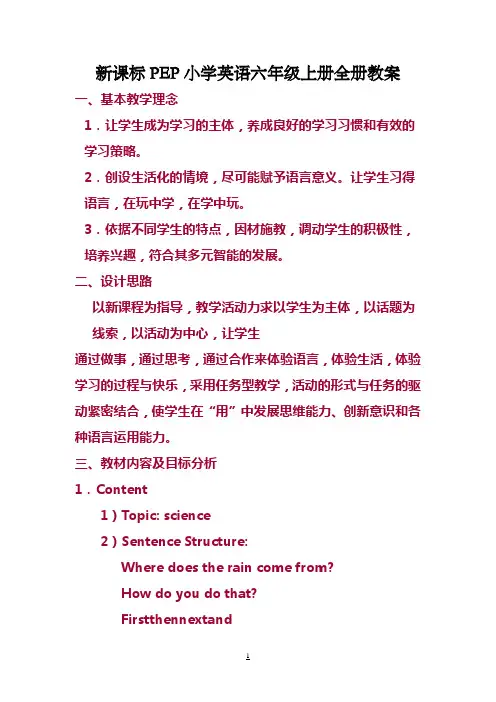
新课标PEP小学英语六年级上册全册教案一、基本教学理念1.让学生成为学习的主体,养成良好的学习习惯和有效的学习策略。
2.创设生活化的情境,尽可能赋予语言意义。
让学生习得语言,在玩中学,在学中玩。
3.依据不同学生的特点,因材施教,调动学生的积极性,培养兴趣,符合其多元智能的发展。
二、设计思路以新课程为指导,教学活动力求以学生为主体,以话题为线索,以活动为中心,让学生通过做事,通过思考,通过合作来体验语言,体验生活,体验学习的过程与快乐,采用任务型教学,活动的形式与任务的驱动紧密结合,使学生在“用”中发展思维能力、创新意识和各种语言运用能力。
三、教材内容及目标分析1.Content1)Topic: science2)Sentence Structure:Where does the rain come from?How do you do that?Firstthennextand3)Words: stream, vapor, seed, soil, sprout, rain, cloud, sun, plant2.Main Point:Reading of the story about water cycleDifficult Point:The ways to describe the process, e.g. Firstthennextand3.Goals1)知识目标:掌握课文单词和句子结构掌握音标与的长短区别读懂文章water cycle和painting,并能依照图片或范文进行仿写和填空2)能力目标:交流与合作日常生活常识的听说读写学习策略上学习归纳如何描述说明事物的过程“First, then, next, and或者first, second, third,等等”3)情感目标:科学合理有效地安排生活中的事物顺序,能对过程及程序给出自己的建议,学会仔细观察和科学有效利用时间。
通过对物质的几种形态变化的了解,培养学生的科学探究意识。
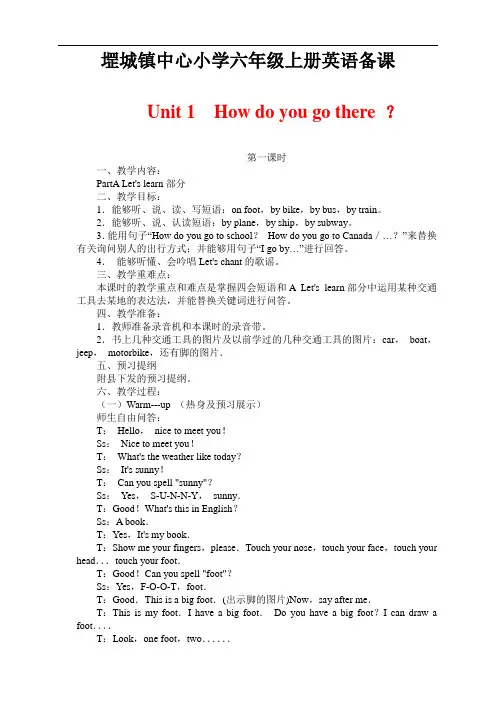
堽城镇中心小学六年级上册英语备课Unit 1 How do you go there ?第一课时一、教学内容:PartA Let's learn部分二、教学目标:1.能够听、说、读、写短语:on foot,by bike,by bus,by train。
2.能够听、说、认读短语:by plane,by ship,by subway。
3.能用句子“How do you go to school?How do you go to Canada/…?”来替换有关询问别人的出行方式;并能够用句子“I go by…”进行回答。
4.能够听懂、会吟唱Let's chant的歌谣。
三、教学重难点:本课时的教学重点和难点是掌握四会短语和A Let's learn部分中运用某种交通工具去某地的表达法,并能替换关键词进行问答。
四、教学准备:1.教师准备录音机和本课时的录音带。
2.书上几种交通工具的图片及以前学过的几种交通工具的图片:car,boat,jeep,motorbike,还有脚的图片.五、预习提纲附县下发的预习提纲。
六、教学过程:(一)Warm---up (热身及预习展示)师生自由问答:T:Hello,nice to meet you!Ss:Nice to meet you!T:What's the weather like today?Ss:It's sunny!T:Can you spell "sunny"?Ss:Yes,S-U-N-N-Y,sunny.T:Good!What's this in English?Ss:A book.T:Yes,It's my book.T:Show me your fingers,please.Touch your nose,touch your face,touch your head...touch your foot.T:Good!Can you spell "foot"?Ss:Yes,F-O-O-T,foot.T:Good.This is a big foot.(出示脚的图片)Now,say after me.T:This is my foot.I have a big foot.Do you have a big foot?I can draw a foot....T:Look,one foot,two......Ss:Two feet.T:Good,two feet.I have two feet.How many feet do you have?How many feet can you see?These are my feet.My feet are big.T:Look!I can draw a picture.(二)Presentation and practice(精讲点拨)(1)教师在黑板上画一座房子,说:This is my home..再画一所四层的大楼,为我们小学,(它们之间很近)教师画一条路,再画一个闹钟,说:"look,what time is it?”学生看后说;“It‘s nine o’clock.""Good,it's time to go to school!My home is near,I go to school on foot."教师边说边做背书包上学的动作,同时脚踏地慢慢往前走,让学生感受句型,教师多说几遍,把句型书写在黑板上,划出词组,让学生跟读,自己体会,让学生根据自己的实际情况来说自己是走路上学,体会on的意思.(2)教师再画一座房子,离学校很远,说:"Now,this is my home ,my home is here.It' s far from my school.I go to school by bike.(教师边说边做骑车的动作)"把此句型写在黑板上,教读,学生体会,并介绍自己是骑车来上学.(3)教师出示自行车的卡片,同时拿出别的交通工具的卡片,放在句型中bike 的上面,进行替换,学生说完整的句子,I go to school by ship.I go to school by bus.I go to school by plane.(4)出示train的图片,问:"What's this in English?Oh,it's a train.train.教师带领学生组词造句,巩固此单词.S1:This is a train.S2:I have a train.S3:There is a train.S4:I can see a train.S5:The train is on the desk.S6:How many trains can you see?S7:How many trains do you have?S8:I go to school by train.S9:I like train.S10:Where is my train.(5)以同样的方法教单词subway.(6)教师再带读一遍,把一本书卷成一个话筒,做采访人的样子,问一个程度较好的学生,教师可以帮助学生回答,T:Excuse me,How do you go to school?T and S:I go to school on foot.教师多问几位同学,让学生感受问句.教师书写问句,带领学生读,师生交换读,(多种方式读)(7)学生进行操练,先同桌互练,再在全班表演.(8)教师出示几个国家的国旗(图片)问学生:T:Look,is this Japan?Ss:No,it's Canada.T:Good,how do you go to Canada?Ss:(教师拿飞机的卡片)I go to Canada by plane.(9)学生反复造句,自由问答.(三)Consolidation and extension(拓展延伸)(1)让学生采访老师S:How do you go to school?T:I go to school on foot.S:How do you go to Canada?T:I go by plane.教师书写此句在黑板上,讲解省略的部分.学生补充完整省略的部分.(2)学生练习.(3)听磁带,跟读,感受语音语调.(四)Sum-up(总结)(五)The limited—time exercise (限时作业)学生做县下发的限时作业.(六)Check and explain(检查限时作业并反馈)学生互相批阅限时作业,发现问题,分析原因,并且反馈矫正。
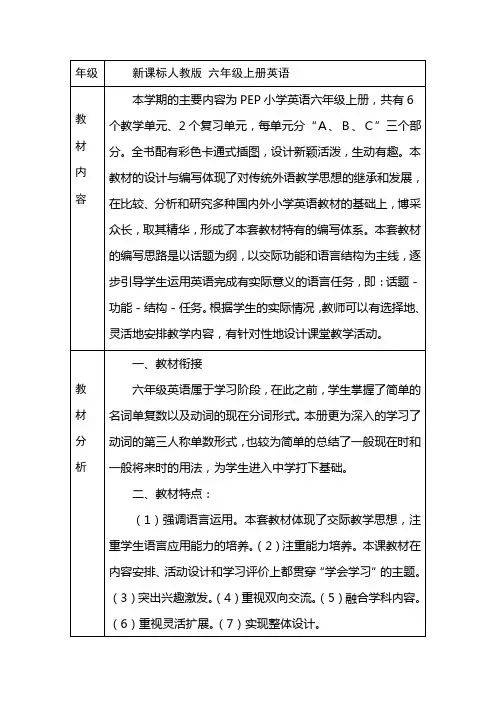
年级 新课标人教版 六年级上册英语 教 材 内 容
本学期的主要内容为PEP小学英语六年级上册,共有6个教学单元、2个复习单元,每单元分“A、B、C”三个部分。全书配有彩色卡通式插图,设计新颖活泼,生动有趣。本教材的设计与编写体现了对传统外语教学思想的继承和发展,在比较、分析和研究多种国内外小学英语教材的基础上,博采众长,取其精华,形成了本套教材特有的编写体系。本套教材的编写思路是以话题为纲,以交际功能和语言结构为主线,逐步引导学生运用英语完成有实际意义的语言任务,即:话题-功能-结构-任务。根据学生的实际情况,教师可以有选择地、灵活地安排教学内容,有针对性地设计课堂教学活动。
教 材 分 析 一、教材衔接 六年级英语属于学习阶段,在此之前,学生掌握了简单的名词单复数以及动词的现在分词形式。本册更为深入的学习了动词的第三人称单数形式,也较为简单的总结了一般现在时和一般将来时的用法,为学生进入中学打下基础。 二、教材特点: (1)强调语言运用。本套教材体现了交际教学思想,注重学生语言应用能力的培养。(2)注重能力培养。本课教材在内容安排、活动设计和学习评价上都贯穿“学会学习”的主题。(3)突出兴趣激发。(4)重视双向交流。(5)融合学科内容。(6)重视灵活扩展。(7)实现整体设计。 教 学 目 标
1、能按四会、三会的要求掌握所学单词和句型。 2、能使用日常交际用语,活用四会句型,进行简单的交流,做到大胆开口,发音正确。 3、能在图片、手势、情境等非语言提示的帮助下,听懂清晰的话语和录音。 4、进一步养成良好的书写习惯,以及听英语、读英语和说英语的良好习惯。 教学重难 点 重点:1、能四会掌握各单元的重点词汇和句型; 2、能在情境中恰当运用所学重点句型; 3、能独立完成每单元的练习。 难点:1、能四会掌握各单元的重点词汇和句型; 2、重点句型在恰当情境中的初步运用。 单元知识点之间的联系 横向联系: 主情景图:在真实情境中呈现本单元主要词汇及句型 A&B Let’s talk & Let’s talk等:学习主要词汇和句型 B Read and write:阅读文段获取主旨大意和相关细节信息,回答问题 Let’s check & Let’s wrap it up:通过听力和阅读活动,检测评价学生的学习效果 C Story time:运用本单元所学核心语言讲述趣味故事,引起学生学习英语的兴趣,扩大学生阅读量 纵向联系: 问路有关的词汇 Unit1 How can I get there ? 关于问路的功能句
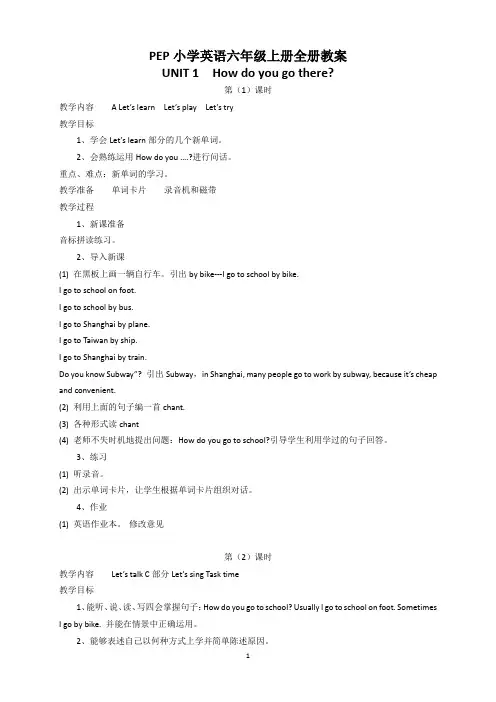
PEP小学英语六年级上册全册教案UNIT 1 How do you go there?第(1)课时教学内容 A Let’s learn Let’s play Let’s try教学目标1、学会Let’s learn部分的几个新单词。
2、会熟练运用How do you ….?进行问话。
重点、难点:新单词的学习。
教学准备单词卡片录音机和磁带教学过程1、新课准备音标拼读练习。
2、导入新课(1) 在黑板上画一辆自行车。
引出by bike---I go to school by bike.I go to school on foot.I go to school by bus.I go to Shanghai by plane.I go to Taiwan by ship.I go to Shanghai by train.Do you know Subway”? 引出Subway,in Shanghai, many people go to work by subway, because it’s cheap and convenient.(2) 利用上面的句子编一首chant.(3) 各种形式读chant(4) 老师不失时机地提出问题:How do you go to school?引导学生利用学过的句子回答。
3、练习(1) 听录音。
(2) 出示单词卡片,让学生根据单词卡片组织对话。
4、作业(1) 英语作业本。
修改意见第(2)课时教学内容Let’s talk C部分Let’s sing Task time教学目标1、能听、说、读、写四会掌握句子:How do you go to school? Usually I go to school on foot. SometimesI go by bike. 并能在情景中正确运用。
2、能够表述自己以何种方式上学并简单陈述原因。
教学重点难点重点:听、说、读、写句型:How do you go to school? Usually/Sometimes I go by…难点:学生书写四会句子并能简单陈述选择某种交通方式上学的原因教学准备录音机和磁带单词卡片教学过程1、热身(1)复习上一课时对话(2)放Let’s sing 的歌曲2、预习(1)教师出示单词卡片,提问:How do you go to school?(2)做Let’s try的题目。
六年级英语Module 1 Unit 1It’s more than twenty thousand kilometres long.课型:新授课(第一课时)学习目标:1、能够听、说、读、写本单元的单词和基本句型。
2、能听懂会说:These postcards are great!Tell me more about...How long is it?并能回答3、学会用英语讲述某个地方或某件事物的情况。
教学重难点:1、准确理解对话中的语句,掌握单词和基本句型,并能正确书写。
熟练区分运用am\is\are.2、会用“Can you tell me something about ┅? Can you tell me more about it? ”等问句,并能回答“Yes,it’s ┅”学情分析:在学生已掌握Is it…? 及回答Yes,it is.\No,it isn’t.句型的基础上进一步学习How long\big...?相关的句型。
通过长城了解中国,通过纽约了解美国。
学会如何描述一个景点,一座城市或它们的地理位置等。
教具学具准备:点读机、PPT、景点照片等教学过程:一、热身复习(Warm up)1. 老师热情地问候学生们,欢迎他们在暑假过后回到学校。
老师可以询问学生们在假期里都去了哪些地方,做了哪些事情,有没有特别有趣的经历。
建议他们通过展示图片和照片介绍相关的情况,可以使用句型“It’s a picture of….It's very…”等。
2.Listen and chant.(点读课本Activity 1,Ss chant)二、导入1. 老师从学生的图片或照片中选取几张比较典型的并提问:T: Do you know this place? (引导全班学生自由回答)Ss: Yes,it’s…..T:Can you tell me something about it?(问几个程度较好的学生,让学生初步感知Can you tell me……句型。
最新人教版六年级英语上册教案(全册)小学英语六年级上册全册课程纲要◆课程类型:必修课程◆教学材料:人民教育出版社◆课时安排:42课时◆授课对象:小学六年级一、课程标准相关的陈述能借助录音、图像、手势听懂简单的话语或录音材料;能听懂课堂活动中简单的提问;能在口头表达中做到发音清楚,语调根本达意;能认读所学词语;能根据拼读的规律,读出简单的单词;能读懂教材中简短的要求或指令;能正确地使用大写小字母和常用的标点符号;能根据图片、词语或例句的提示,写出简短的语句. 学习目标:1、我能够借助拼读规那么、图片听、说、读、写64个短语和单词以及12组句子和9个单句〔包括社区生活,交通法规,课余活动,业余爱好,职业,心情等几个话题〕。
要求能在真实语境中正确运用并能读懂简短语篇。
2、我能够借助拼读规那么、图片听、说、认读83个单词〔带“△〞〕。
3、我能借助录音能听懂、会唱6首歌曲。
4、我能根据练习,作业及小组合作完成6个自我评价活动。
5、我能借助动画理解6个幽默小故事。
6、我能借助课本,课件了解6项简单的中西方文化生活知识。
能力目标: 1、我能借助录音,图片使用日常交际用语,活用四会句型,进行简单的交流,做到大胆开口,发音正确。
2、我能在图片、手势、情境等非语言提示的帮助下,听懂清晰的话语和录音。
3、养成良好的书写习惯。
4、进一步养成听英语、读英语和说英语的良好习惯。
二、课时安排1单元课题课时 Unit 1 How can I get there? 6 Unit 2 Ways to go to school 6 Unit 3 My weekend plan 6 Recycle 1 3 Unit 4 I have a pen pal 6 Unit 5 What does he do ? 6 Unit 6 How do you feel? 6 Recycle 2 3 三、课程实施 1、六年级上册的教材与五年级上、下册的结构、板块设计根本相同,不同之处主要有以下两个方面:(1)五年级上、下册教材中的主句型在 Let's talk 局部只要求到达听、说、认读,在 Read and write 局部要求到达能够书写。
小学英语六年级上册教案5篇(经典版)编制人:__________________审核人:__________________审批人:__________________编制单位:__________________编制时间:____年____月____日序言下载提示:该文档是本店铺精心编制而成的,希望大家下载后,能够帮助大家解决实际问题。
文档下载后可定制修改,请根据实际需要进行调整和使用,谢谢!并且,本店铺为大家提供各种类型的经典范文,如工作汇报、述职报告、发言致辞、心得体会、规章制度、应急预案、合同协议、教学资料、作文大全、其他范文等等,想了解不同范文格式和写法,敬请关注!Download tips: This document is carefully compiled by this editor. I hope that after you download it, it can help you solve practical problems. The document can be customized and modified after downloading, please adjust and use it according to actual needs, thank you!Moreover, our store provides various types of classic sample essays for everyone, such as work reports, job reports, speeches, insights, rules and regulations, emergency plans, contract agreements, teaching materials, complete essays, and other sample essays. If you want to learn about different sample formats and writing methods, please pay attention!小学英语六年级上册教案5篇下面是本店铺整理的小学英语六年级上册教案5篇 2024pep小学英语六年级教案,供大家赏析。
10月8日整理一至三模块的知识网络梳理,以及检测重难点知识
课后反思:通过练习,学生们的综合语言运用能力有长进,变换句子结构还有代进行训练。
10月22日做能力培养
课后反思;通过各种形式练习,教师对本课进行说的能力的培养和训练,达到较好的效果,对划线提问方面的练习还需进一步提高。
10、26新课程能力培养
变换词性答得不是很好,需要加强这方面的练习,其他题型学生普遍答得较好。
本模块主要知识点掌握较好。
10、29月考当堂检测
详见卷子。
课时计划年 10 月 29 日
变换词性答得一般,讲完以后学生都明白了;选择填空答得较好;用所给动词正确形式填空答得不好,各种时态混合在一起,学生有点乱套,一道道讲解后学生就能抢答了,介词填空答得还可以。
以后应该多加强课文的背诵,坚持课课背诵,这样做填空题效果能更好些。
小学六年级英语上册全册备课
邵庄镇文登小学 付正芹
一、学生情况
本学期,我接任六年级英语教学任务,该班共有学生
人,由于班人数比较多,对教师课堂上学生的操练和课后的
培优辅差都带来了一定的难度。学生基础差,但学生对英语
的学习比较感兴趣。作为教师,可以抓住这一点,调动的积
极性,活跃课堂。
二、教材分析
《小学新标准英语》第七册,共有10个模块,在每个模
块钟均有两个单元和复习模块,每单元设计了以下几个部
分:首先是listen ,point and find。在这部分学生会看
到本单元的基本故事,书中的小朋友在用英语互相交流。学
生要认真听,认真看,理解他们在干些什么,说些什么,然
后努力去学着说。然后是Listen and say。这部分是对重点
句型的练习与巩固。接着是practise。这部分设计了一些课
堂活动。学生可以按照书中的范例,运用前面学到的表达方
法进行交流,进一步巩固和提高用英语听、说、做、玩、演
的技能。第二单元还专门设计了listen and say.then sing。
在这里,同学们可以结合本单元的内容,唱一唱,说一说,
玩一玩,做一做,动动脑筋,使英语学习成为一件快乐的事
情。
这学期的教学内容,在继续培养学生的听、说、写的基
础上,继续侧重学生阅读理解方面的能力,同时也继续要求
学生在写能力方面进行要求,引导学生写出简单的小短文。
继续对出现在每一个模块中的语法点进行形象的,生动的讲
解。做好小学阶段的复习工作。在复习阶段,应该加大练习
量,在复习中提高学生的口头表达和复习重点:
三、教学目标
1.能按四会、三会的要求掌握所学单词。
2. 能按四会要求掌握所学句型。
3. 能使用日常交际用语,活用四会句型,进行简单的
交流,做到大胆开口、发音正确。
4. 能在图片、手势、情境等非语言提示的帮助下,听
懂清晰的话语和录音。
5. 初步培养良好的书写习惯,能做到书写整洁规范。
四、教学措施
1. 以活动为课堂教学的主要形式,设计丰富多彩的教
学活动,如游戏、竞赛、猜谜、音乐、诗歌、扮演角色等活
动,使教学情趣化,让学生在乐中学,学中用。
2. 通过听、说、读、写、演等形式进行大量的语言操
练和练习。
3.尽可能为学生学习语言创造情境,将利用图片、模型、
实物、简笔画等直观教具和录音、录像等电教手段相结合,
为学生打下良好的语言基础。
4. 设计全面高效的课外作业,培养良好的书写习惯。
五、课时安排
教学模块 计划课时 教学模块 计划课时
Module 1 3课时 Module 6 4课时
Module 2 4课时 Module 7 3课时
Module 3 4课时 Module 8 4课时
Module 4 3课时 Module 9 3课时
Module 5 4课时 Module 10 3课时
Review Module
5课时